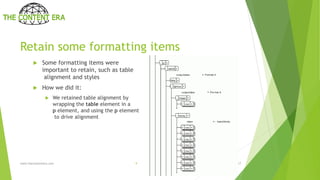LavaCon 2017 - Implementing a Customer Driven Transition to DITA - Part 1
- 1. Implementing a Customer-driven Transition to DITA Content A Step-by-Step Journey to Success www.thecontentera.com 111/2/2017
- 2. President – Director Tech Comm – SVP Global Operations – Founder/CEO – Founder/CEO - Tom Aldous Email: [email protected] Blog: www.tmaldous.com YouTube: http://bit.ly/TheContentEra_YouTube www.thecontentera.com 2 11/2/2017 - 30 Years in Technical Communication - XML Expert - Certified FrameMaker Expert - Structured Authoring Wizard - DITA Specialization Expert - Content Strategist - Industry Influencer
- 3. About Us We love solving problems in real-world conditions. We help you identify the tools and strategies that work best for your content. Then, we train you to use them effectively. We can help you with structured content creation and management. Our knowledge of content tools, markup languages, scripting/automation, and best practices reduces cycle time and increases efficiency. We know your existing content is valuable: many of our projects involve conversions to structured content and between XML standards. www.thecontentera.com 3 11/2/2017
- 4. Today’s goal and how we can help Demonstrate one client’s unique issues and showcase the TCE solution. Every company has a unique set of requirements and issues. Cookie- cutter solutions cannot address unique content. Existing content rarely translates directly to the DITA standard - creative solutions built with XSLT, read-write rules and scripts prepare your content for the transition. If you do not need to convert content and your solution is simple, we can train you to modify templates to extend out-of-box solutions. www.thecontentera.com 4 11/2/2017
- 5. Challenges Categorize topics as concept, reference, or task upon conversion. Minimize content rework before conversion (such as untangling conceptual information from procedures). Retain some formatting items, such as table alignment. Retain some unstructured FrameMaker features in early phases to support a phased transition. Address legacy content that inherently includes overrides, formatting tags, cross-reference issues, and other difficult-to-find remnants. Retain cross-references over topic chunking. Automate process as much as possible to avoid disruption Deliver a user-friendly publishing solution that allows import of variables and conditions www.thecontentera.com 5 11/2/2017
- 6. Creative solutions for unique content www.thecontentera.com 6 11/2/2017 Structured Application Scripts Read/Write Rules Stylesheets
- 7. Categorize topics How we did it: Apply unique paragraph tag only to the headings of reference and conceptual information Creative handling of the conversion table to convert every topic to the strictest topic type: task Stylesheet to correctly categorize topics into concepts, references, and tasks www.thecontentera.com 7 11/2/2017
- 8. Minimize content rework before conversion Some “topics” contain multiple information types in the unstructured environment How we did it: Convert procedures by nesting tasks to generate valid XML upon conversion Let each authoring team define the schedules for “untangling” content, such as removing conceptual information from procedures www.thecontentera.com 8 11/2/2017
- 9. Retain some formatting items Some formatting items were important to retain, such as table alignment and styles How we did it: We retained table alignment by wrapping the table element in a p element, and using the p element to drive alignment www.thecontentera.com 9 11/2/2017
- 10. Retain some unstructured FM features Since our approach is a phased one, we need to retain variables and conditional text in the early phases. How we did it: Use FrameMaker conditions as in unstructured FrameMaker Wrap variables in ph element and continue to use the FrameMaker Variables dialog as in unstructured FrameMaker Publishing solution imports variables and conditions across the publication www.thecontentera.com 10 11/2/2017
- 11. Address legacy content: character formats Character formats are sometimes incorrectly applied (do not use character format tags) How we did it: Created script to search for incorrectly applied character formats and capture these in the conversion table www.thecontentera.com 11 11/2/2017
- 12. Address legacy content: formatting tags Many paragraph tags in the unstructured template are used solely for formatting, and therefore need to be deleted How we did it: Created script to search for and delete formatting paragraph tags www.thecontentera.com 12 11/2/2017
- 13. Address legacy content: X-ref issues Common problems with cross-references in legacy content include: Multiple paragraphs with identical X-Ref marker. This occurs because new chapters were created from existing chapters (h1 X-Ref marker duplicated when new chapter created). Paragraphs with more than one X-Ref marker. This occurs frequently because index markers are mistakenly inserted as X-Ref markers. How we did it: Created script to add the chapter name as the prefix to every cross- reference marker. This ensures X-Ref markers are unique. Created script to check for and fix paragraphs with multiple X-Ref markers. www.thecontentera.com 13 11/2/2017
- 14. Address legacy content: graphics Many legacy graphics include multiple (and sometimes hidden) frames How we did it: Created script to check every anchored frame for composite graphics www.thecontentera.com 14 11/2/2017
- 15. Retain X-Refs over topic chunking How we did it: Merge book and then fix resulting unresolved cross-references Fix legacy cross-reference issues Created script to generate the correct link format for cross-references (append idref to the href following # symbol) www.thecontentera.com 15 11/2/2017
- 16. Automate process How we did it: Created a user-friendly workflow by: Allowing authors to run scripts from custom built menu in FrameMaker Using different structured applications during conversion and authoring Using Read/Write rules to roundtrip XML Using stylesheets to adjust structure where necessary www.thecontentera.com 16 11/2/2017
- 17. Publishing solution How we did it: Leveraged and extended the out-of-the-box FrameMaker publishing solution Used ditafm-output.ini file to define PDF publishing parameters Built FM book from ditamap Created script to import variables and conditional text settings from a predefined “control” file (saved in the same folder as the ditamap) Generated book also used to output responsive HTML5 (using the FrameMaker Publish dialog) www.thecontentera.com 17 11/2/2017
















